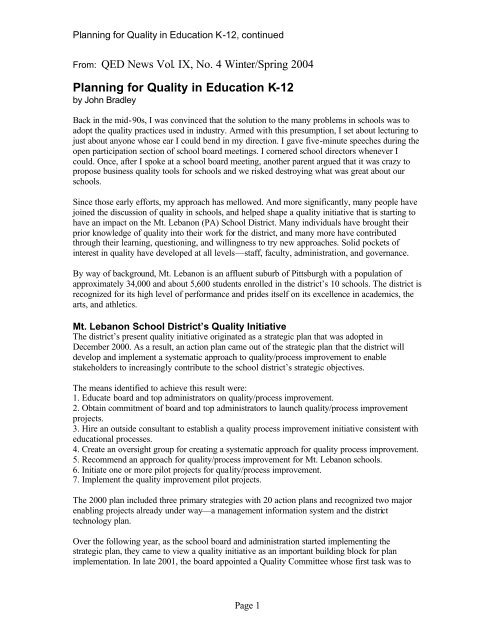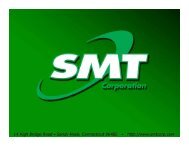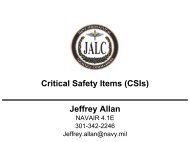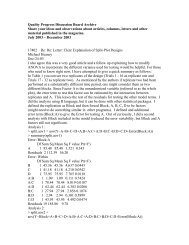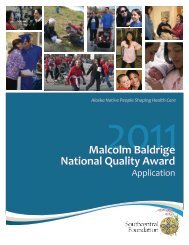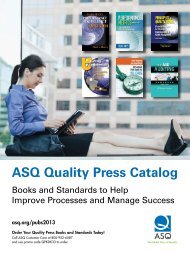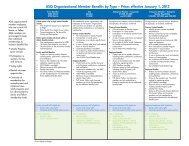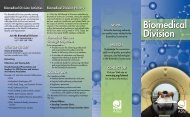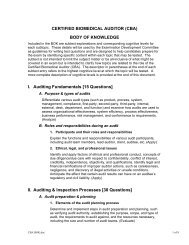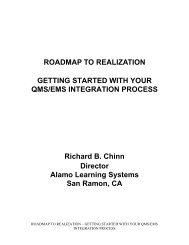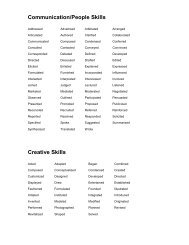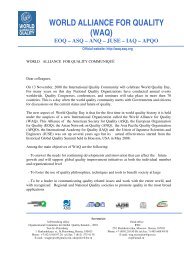Planning for Quality in Education K-12
Planning for Quality in Education K-12
Planning for Quality in Education K-12
You also want an ePaper? Increase the reach of your titles
YUMPU automatically turns print PDFs into web optimized ePapers that Google loves.
<strong>Plann<strong>in</strong>g</strong> <strong>for</strong> <strong>Quality</strong> <strong>in</strong> <strong>Education</strong> K-<strong>12</strong>, cont<strong>in</strong>ued<br />
From: QED News Vol. IX, No. 4 W<strong>in</strong>ter/Spr<strong>in</strong>g 2004<br />
<strong>Plann<strong>in</strong>g</strong> <strong>for</strong> <strong>Quality</strong> <strong>in</strong> <strong>Education</strong> K-<strong>12</strong><br />
by John Bradley<br />
Back <strong>in</strong> the mid-90s, I was conv<strong>in</strong>ced that the solution to the many problems <strong>in</strong> schools was to<br />
adopt the quality practices used <strong>in</strong> <strong>in</strong>dustry. Armed with this presumption, I set about lectur<strong>in</strong>g to<br />
just about anyone whose ear I could bend <strong>in</strong> my direction. I gave five-m<strong>in</strong>ute speeches dur<strong>in</strong>g the<br />
open participation section of school board meet<strong>in</strong>gs. I cornered school directors whenever I<br />
could. Once, after I spoke at a school board meet<strong>in</strong>g, another parent argued that it was crazy to<br />
propose bus<strong>in</strong>ess quality tools <strong>for</strong> schools and we risked destroy<strong>in</strong>g what was great about our<br />
schools.<br />
S<strong>in</strong>ce those early ef<strong>for</strong>ts, my approach has mellowed. And more significantly, many people have<br />
jo<strong>in</strong>ed the discussion of quality <strong>in</strong> schools, and helped shape a quality <strong>in</strong>itiative that is start<strong>in</strong>g to<br />
have an impact on the Mt. Lebanon (PA) School District. Many <strong>in</strong>dividuals have brought their<br />
prior knowledge of quality <strong>in</strong>to their work <strong>for</strong> the district, and many more have contributed<br />
through their learn<strong>in</strong>g, question<strong>in</strong>g, and will<strong>in</strong>gness to try new approaches. Solid pockets of<br />
<strong>in</strong>terest <strong>in</strong> quality have developed at all levels—staff, faculty, adm<strong>in</strong>istration, and governance.<br />
By way of background, Mt. Lebanon is an affluent suburb of Pittsburgh with a population of<br />
approximately 34,000 and about 5,600 students enrolled <strong>in</strong> the district’s 10 schools. The district is<br />
recognized <strong>for</strong> its high level of per<strong>for</strong>mance and prides itself on its excellence <strong>in</strong> academics, the<br />
arts, and athletics.<br />
Mt. Lebanon School District’s <strong>Quality</strong> Initiative<br />
The district’s present quality <strong>in</strong>itiative orig<strong>in</strong>ated as a strategic plan that was adopted <strong>in</strong><br />
December 2000. As a result, an action plan came out of the strategic plan that the district will<br />
develop and implement a systematic approach to quality/process improvement to enable<br />
stakeholders to <strong>in</strong>creas<strong>in</strong>gly contribute to the school district’s strategic objectives.<br />
The means identified to achieve this result were:<br />
1. Educate board and top adm<strong>in</strong>istrators on quality/process improvement.<br />
2. Obta<strong>in</strong> commitment of board and top adm<strong>in</strong>istrators to launch quality/process improvement<br />
projects.<br />
3. Hire an outside consultant to establish a quality process improvement <strong>in</strong>itiative consistent with<br />
educational processes.<br />
4. Create an oversight group <strong>for</strong> creat<strong>in</strong>g a systematic approach <strong>for</strong> quality process improvement.<br />
5. Recommend an approach <strong>for</strong> quality/process improvement <strong>for</strong> Mt. Lebanon schools.<br />
6. Initiate one or more pilot projects <strong>for</strong> quality/process improvement.<br />
7. Implement the quality improvement pilot projects.<br />
The 2000 plan <strong>in</strong>cluded three primary strategies with 20 action plans and recognized two major<br />
enabl<strong>in</strong>g projects already under way—a management <strong>in</strong><strong>for</strong>mation system and the district<br />
technology plan.<br />
Over the follow<strong>in</strong>g year, as the school board and adm<strong>in</strong>istration started implement<strong>in</strong>g the<br />
strategic plan, they came to view a quality <strong>in</strong>itiative as an important build<strong>in</strong>g block <strong>for</strong> plan<br />
implementation. In late 2001, the board appo<strong>in</strong>ted a <strong>Quality</strong> Committee whose first task was to<br />
Page 1
<strong>Plann<strong>in</strong>g</strong> <strong>for</strong> <strong>Quality</strong> <strong>in</strong> <strong>Education</strong> K-<strong>12</strong>, cont<strong>in</strong>ued<br />
hire a consultant to help <strong>in</strong> develop<strong>in</strong>g and implement<strong>in</strong>g an approach to quality process<br />
improvement.<br />
The committee solicited proposals and after hear<strong>in</strong>g presentations from four quality consultants,<br />
recommended a primary out-of-state consultant to lead the <strong>in</strong>itiative and another consultant to be<br />
a local resource <strong>for</strong> cont<strong>in</strong>ued tra<strong>in</strong><strong>in</strong>g as the <strong>in</strong>itiative unfolds. Hank Grimmick, a senior Baldrige<br />
exam<strong>in</strong>er from Cali<strong>for</strong>nia, was the lead consultant, and the local consultant was Craig Vogel, a<br />
dean and professor of <strong>in</strong>dustrial design at Carnegie Mellon University (CMU). Vogel had been<br />
<strong>in</strong>volved with CMU’s quality program <strong>for</strong> several years and is a Mt. Lebanon resident. Both of<br />
these consultants have played valuable roles <strong>in</strong> our journey—Grimmick’s vast experience with<br />
many types of organizations <strong>in</strong> adopt<strong>in</strong>g quality and Vogel’s comb<strong>in</strong>ation of quality work <strong>in</strong> an<br />
academic <strong>in</strong>stitution and his expertise <strong>in</strong> the process design.<br />
The consultants proceeded to lead the committee through a process to adopt a Baldrige approach<br />
to conduct an <strong>in</strong>ternal assessment, and select two pilot projects. The <strong>in</strong>tent <strong>in</strong> select<strong>in</strong>g two pilot<br />
projects was to demonstrate quality practices <strong>in</strong> time <strong>for</strong> the com<strong>in</strong>g school year. The committee<br />
developed a list of 11 practical problems <strong>for</strong> which a solution would affect work life and provide<br />
a statement about quality. The two projects adopted addressed areas of considerable discontent—<br />
the purchas<strong>in</strong>g process and the work order process. Teams were <strong>for</strong>med, tra<strong>in</strong>ed, and supported<br />
to do their projects. Even though the projects were not completed <strong>in</strong> time <strong>for</strong> a start-of-school<br />
kickoff, the f<strong>in</strong>al outcomes were highly successful. The just-<strong>in</strong>-time tra<strong>in</strong><strong>in</strong>g program elim<strong>in</strong>ated<br />
waste and significantly improved teacher satisfaction with the supply process.<br />
In October, an Internal Assessment Team, consist<strong>in</strong>g of 10 members of faculty, adm<strong>in</strong>istration,<br />
and PTA, was tra<strong>in</strong>ed and supported to conduct a Baldrige self-assessment. The team collectively<br />
spent more than 1800 hours conduct<strong>in</strong>g <strong>in</strong>terviews, gather<strong>in</strong>g and analyz<strong>in</strong>g data, and prepar<strong>in</strong>g a<br />
report to the district. The report, first presented <strong>in</strong> December 2002, was very well received and<br />
represented a milestone <strong>in</strong> open self-exam<strong>in</strong>ation <strong>for</strong> the district and public acknowledgment that<br />
an excellent school district can strive <strong>for</strong> significant improvement.<br />
By early 2003, the successes of the <strong>in</strong>ternal assessment and pilot projects provided a strong<br />
foundation <strong>for</strong> the <strong>in</strong>itiative. Project presentations were repeated throughout the district to<br />
re<strong>in</strong><strong>for</strong>ce the recommendations and educate on quality. An additional challenge <strong>for</strong> the district <strong>in</strong><br />
2003 was to prepare <strong>for</strong> the retirement of the super<strong>in</strong>tendent, Dr. Glenn Smartschan, and search<br />
<strong>for</strong> a new super<strong>in</strong>tendent.<br />
The <strong>in</strong>ternal assessment team recommended six high-leverage action items. After review by the<br />
adm<strong>in</strong>istration, the <strong>Quality</strong> Committee, and the board, a decision was made to fund two additional<br />
projects <strong>for</strong> the year 2003-04:<br />
? Develop and implement a systematic process to evaluate, measure, and drive cont<strong>in</strong>uous<br />
improvement <strong>in</strong> faculty/staff well-be<strong>in</strong>g, satisfaction, and motivation.<br />
? Develop a systematic process to compare the district with other educational organizations as<br />
well as organizations outside of education.<br />
In spr<strong>in</strong>g 2003, the school district underwent a significant adm<strong>in</strong>istrative change with import <strong>for</strong><br />
the quality <strong>in</strong>itiative—the retirement of Super<strong>in</strong>tendent Glenn Smartschan and the hir<strong>in</strong>g of a new<br />
super<strong>in</strong>tendent, Dr. Marge Sable. With a set of board-directed goals to be accomplished, Dr.<br />
Sable embraced the quality <strong>in</strong>itiative and determ<strong>in</strong>ed that the <strong>Quality</strong> Committee was the<br />
appropriate vehicle through which major plann<strong>in</strong>g should occur. Over the summer, the <strong>Quality</strong><br />
Committee was restructured and expanded with five subcommittees charged to:<br />
Page 2
<strong>Plann<strong>in</strong>g</strong> <strong>for</strong> <strong>Quality</strong> <strong>in</strong> <strong>Education</strong> K-<strong>12</strong>, cont<strong>in</strong>ued<br />
? Develop a systematic process to evaluate, measure, and drive cont<strong>in</strong>uous improvement <strong>in</strong><br />
faculty/staff well-be<strong>in</strong>g, satisfaction, and motivation.<br />
? Develop a systematic process to compare the district with other educational organizations<br />
as well as organizations outside of education (i.e., benchmark<strong>in</strong>g).<br />
? Develop preventive ma<strong>in</strong>tenance systems <strong>for</strong> facilities, <strong>in</strong>clud<strong>in</strong>g grounds (e.g., a follow<br />
through on the work order pilot project).<br />
? Develop a relevant plan to move the district toward becom<strong>in</strong>g a world-class learn<strong>in</strong>g<br />
community with<strong>in</strong> five years (i.e., strategic plann<strong>in</strong>g)<br />
? Develop an effective system <strong>for</strong> the district to identify private grant funds and implement<br />
such systems.<br />
As of this writ<strong>in</strong>g <strong>in</strong> January 2004, the work <strong>in</strong> each of these areas is under way with expanded<br />
teams, tra<strong>in</strong>ers/facilitators, and a commitment to and ground<strong>in</strong>g <strong>in</strong> quality practice.<br />
Reflections on Changes<br />
The events of the past four years have laid a solid foundation <strong>for</strong> the quality <strong>in</strong>itiative. Most<br />
significantly, we have proved that a systematic approach to quality process improvement can add<br />
real value to the work of our school district. Second, through the work of the committee, the<br />
<strong>in</strong>ternal assessment, and the pilot projects, a significant core of 30-50 district employees and<br />
volunteers have ga<strong>in</strong>ed a solid foundation <strong>in</strong> quality practices and theory and a correspond<strong>in</strong>g<br />
commitment. A significant portion of these core people have attended Baldrige and other quality<br />
<strong>in</strong> education conferences and there is a grow<strong>in</strong>g discussion of apply<strong>in</strong>g quality tools <strong>in</strong> the<br />
classroom. And f<strong>in</strong>ally the quality <strong>in</strong>itiative and perspective is be<strong>in</strong>g blended <strong>in</strong>to the<br />
adm<strong>in</strong>istrative and governance structure of the district.<br />
In an outstand<strong>in</strong>g school district like Mt. Lebanon, many adm<strong>in</strong>istrative and policy practices are<br />
consistent with good quality. Often the grow<strong>in</strong>g knowledge of quality can re<strong>in</strong><strong>for</strong>ce exist<strong>in</strong>g good<br />
practices. An example of such a practice that is important <strong>for</strong> quality is a graduate survey that has<br />
been conducted <strong>for</strong> the past five years. This survey has been useful to the <strong>Quality</strong> Committee and<br />
to other committees such as the Technology Curriculum Committee convened <strong>in</strong> 2001. A<br />
graduate survey was sent out <strong>in</strong> the third or fourth year after graduation <strong>for</strong> the classes of 2000,<br />
1999, 1998, 1997, 1996, and 1995. This feedback has been a useful illustration of the value of<br />
customer feedback as well as an eye opener about our strengths and areas <strong>for</strong> improvement.<br />
My Involvement<br />
S<strong>in</strong>ce the early ’90s, my <strong>in</strong>volvement has gone through four phases:<br />
Parent/advocate <strong>for</strong> immediate issues affect<strong>in</strong>g my children<br />
Advocacy <strong>for</strong> quality/process improvement<br />
Member of the Strategic <strong>Plann<strong>in</strong>g</strong> Committee (1999-2000)<br />
Member of MLSD’s <strong>Quality</strong> Committee<br />
My <strong>in</strong>volvement began when my second child entered elementary school and was encounter<strong>in</strong>g<br />
the same problems as my first child. From discussion with parents, I knew these were issues not<br />
unique to my family. I also knew from my work <strong>in</strong> quality, that <strong>in</strong> many <strong>in</strong>dustries it would not be<br />
acceptable to not try to improve processes about which customers frequently compla<strong>in</strong>ed.<br />
Page 3
<strong>Plann<strong>in</strong>g</strong> <strong>for</strong> <strong>Quality</strong> <strong>in</strong> <strong>Education</strong> K-<strong>12</strong>, cont<strong>in</strong>ued<br />
Advocacy Phase<br />
After several years of talk<strong>in</strong>g to the elementary school pr<strong>in</strong>cipal, I concluded I need to address<br />
district adm<strong>in</strong>istrative processes. For lack of a better approach, I <strong>in</strong>itiated a discussion with the<br />
super<strong>in</strong>tendent about the school district’s approach to us<strong>in</strong>g customer feedback and the possibility<br />
of <strong>in</strong>tegrat<strong>in</strong>g this issue <strong>in</strong>to the district’s plann<strong>in</strong>g process. I had had considerable professional<br />
experience us<strong>in</strong>g customer feedback and market research <strong>for</strong> quality/process improvement<br />
purposes <strong>in</strong> healthcare. I ended up on a plann<strong>in</strong>g subcommittee, late <strong>in</strong> a plann<strong>in</strong>g process, that<br />
emphasized <strong>in</strong>clusiveness and openness. This discussion on customer feedback has been a<br />
significant theme, out of the limelight, <strong>for</strong> our district’s plann<strong>in</strong>g and quality concerns.<br />
To this day, I recognize that every compla<strong>in</strong>t or problem I have had about my kids’ schools has<br />
been <strong>for</strong> lack of or due to a breakdown <strong>in</strong> an effective process at the classroom or unit level.<br />
This brief experience with a plann<strong>in</strong>g committee <strong>in</strong> 1995 led me to the belief that an educational<br />
campaign on quality approaches <strong>in</strong> <strong>in</strong>dustry was necessary, so I set out to f<strong>in</strong>d opportunities to<br />
talk to school board directors and adm<strong>in</strong>istrators about quality. I utilized the open discussio n<br />
period at the end of board meet<strong>in</strong>gs to deliver five-m<strong>in</strong>ute presentations on quality. I had<br />
breakfast with as many school directors as would meet with me. In these meet<strong>in</strong>gs I would try to<br />
focus on applications of quality relevant to their backgrounds. I researched quality practices <strong>in</strong><br />
bus<strong>in</strong>ess and <strong>in</strong>dustry and discussed how such practices might be relevant to the school district. I<br />
nom<strong>in</strong>ated myself <strong>for</strong> vacancies on the board and used the <strong>in</strong>terviews to expound on the school<br />
board’s need <strong>for</strong> more board members with quality and organizational development experience <strong>in</strong><br />
<strong>in</strong>dustry. Whenever I came across relevant quality articles <strong>in</strong> my work, I would distribute them to<br />
those I thought might listen. One article that I believe was mean<strong>in</strong>gful was from Quirk’s market<br />
research on a Delaware career technical school district that used graduate surveys to aid <strong>in</strong><br />
plann<strong>in</strong>g curriculum improvements.<br />
Strategic <strong>Plann<strong>in</strong>g</strong> Phase<br />
In 1999 I was asked by a board member to apply to be on the Strategic <strong>Plann<strong>in</strong>g</strong> Committee. In<br />
that phone conversation, he expressed his appreciation <strong>for</strong> my ef<strong>for</strong>ts to help the board have a<br />
better understand<strong>in</strong>g of quality. After several years of feel<strong>in</strong>g isolated <strong>in</strong> my ef<strong>for</strong>ts and<br />
wonder<strong>in</strong>g how many people thought I was crazy, this was encourag<strong>in</strong>g. I had also learned a lot<br />
about how to talk about quality <strong>in</strong> the schools environment.<br />
The Strategic <strong>Plann<strong>in</strong>g</strong> Committee <strong>in</strong>volved a 30-person cross-section of the district and<br />
community. The process was led by consultants, Drs. Larry Hugg<strong>in</strong>s and Steve Barone of<br />
Trans<strong>for</strong>mation Systems, Ltd., who provid<strong>in</strong>g tra<strong>in</strong><strong>in</strong>g and an efficient structured process. By<br />
acceptance of the ground rules that <strong>in</strong>cluded decisions by consensus, I was agree<strong>in</strong>g to<br />
subord<strong>in</strong>ate my particular <strong>in</strong>terest. However, as the plann<strong>in</strong>g process progressed, I realized that I<br />
could make a contribution by demonstrat<strong>in</strong>g rather than advocat<strong>in</strong>g, quality practices and<br />
refram<strong>in</strong>g issues <strong>in</strong> quality terms.<br />
The Strategic <strong>Plann<strong>in</strong>g</strong> Committee <strong>in</strong>cluded several school directors and other members who had<br />
had direct experience with quality and organizational development (OD) <strong>in</strong>itiatives <strong>in</strong> <strong>in</strong>dustry. In<br />
addition the action teams <strong>for</strong>med to elaborate on the key strategies also <strong>in</strong>cluded several quality<br />
and OD professionals, <strong>in</strong>clud<strong>in</strong>g the ASQ section chair at that time. Throughout the plann<strong>in</strong>g<br />
process there seemed to be broad <strong>in</strong>terest <strong>in</strong> quality processes and this general <strong>in</strong>terest was<br />
important <strong>in</strong> how we framed issues <strong>in</strong> quality terms and <strong>in</strong> support<strong>in</strong>g the f<strong>in</strong>al recommendation.<br />
<strong>Quality</strong> Committee Phase<br />
Page 4
<strong>Plann<strong>in</strong>g</strong> <strong>for</strong> <strong>Quality</strong> <strong>in</strong> <strong>Education</strong> K-<strong>12</strong>, cont<strong>in</strong>ued<br />
Participation on the <strong>Quality</strong> Committee s<strong>in</strong>ce 2002 has been gratify<strong>in</strong>g <strong>in</strong> see<strong>in</strong>g so much go<br />
seem<strong>in</strong>gly well. With capable people and professional tra<strong>in</strong><strong>in</strong>g and guidance <strong>for</strong> the assessment<br />
and projects, there is less need <strong>for</strong> advocacy, and the opportunities <strong>for</strong> contribution are different. I<br />
f<strong>in</strong>d that I do a lot of listen<strong>in</strong>g, wait<strong>in</strong>g, or look<strong>in</strong>g <strong>for</strong> an opportunity to support or contribute.<br />
In the summer I was appo<strong>in</strong>ted to the <strong>Plann<strong>in</strong>g</strong> Subcommittee. With the expansion of the<br />
subcommittee structure, I have been try<strong>in</strong>g to f<strong>in</strong>d ways to <strong>in</strong>volve other ASQ professionals <strong>in</strong> the<br />
quality subcommittees to provide additional technical support. Although the <strong>in</strong>volvement of<br />
additional ASQ experts <strong>in</strong> the process has been problematic, we have been able to put several<br />
senior ASQ members <strong>in</strong> contact with district staff. Presently, John Bauer, an ASQ Fellow has<br />
been <strong>in</strong>volved <strong>in</strong> the Benchmark<strong>in</strong>g Subcommittee and has been a useful resource on noneducation-related<br />
benchmark<strong>in</strong>g. In general, however, school districts have a hard time<br />
effectively utiliz<strong>in</strong>g outside expert volunteers.<br />
Personal Challenges<br />
Over the years <strong>in</strong> ASQ, I have talked with many parents and professionals who would like to be<br />
<strong>in</strong>volved <strong>in</strong> similar ways <strong>in</strong> their school districts. Below I recount some of the challenges I<br />
encountered dur<strong>in</strong>g my n<strong>in</strong>e years of personal <strong>in</strong>volvement as a quality advocate <strong>in</strong> the school<br />
district. I cannot take credit <strong>for</strong> anyth<strong>in</strong>g that has happened, but I like to th<strong>in</strong>k that I have helped<br />
to make some of it happen. Here are a few po<strong>in</strong>ts to consider:<br />
What is your role? As a bus<strong>in</strong>essperson, or other professional, how can you make a significant<br />
contribution?<br />
One option is to run <strong>for</strong> the elective office of school director. I decided not to run <strong>for</strong> elective<br />
office on the premise that be<strong>in</strong>g a school director would so dilute my focus that I would not be<br />
able to effect mean<strong>in</strong>gful change. This was as much my assessment of my personal capabilities as<br />
of the politics and pressures on school directors.<br />
Another option may be to serve as a consultant. I decided to not participate <strong>in</strong> a consult<strong>in</strong>g<br />
proposal by local ASQ colleagues because I believed my freedom and effectiveness would be<br />
compromised <strong>in</strong> any role other than that of a volunteer.<br />
For most ASQ members, the only viable role will be as a volunteer to support, educate, and<br />
guide. And from this role, here are a few lessons learned:<br />
Listen actively<br />
If you are not an educator <strong>in</strong>volved <strong>in</strong> your schools on a daily or weekly basis, it is hard to know<br />
what is go<strong>in</strong>g on or what people are th<strong>in</strong>k<strong>in</strong>g. And it is very easy to make wrong assumptions. It<br />
is necessary to spend a lot of time listen<strong>in</strong>g and resist<strong>in</strong>g the urge to jump to conclusions.<br />
Effective advocacy is be<strong>in</strong>g an<br />
educator<br />
Advocacy means educat<strong>in</strong>g people on the issues and m<strong>in</strong>imiz<strong>in</strong>g opposition. F<strong>in</strong>d<strong>in</strong>g ways to<br />
educate with appropriate aggressiveness and grace is always a challenge.<br />
.<br />
Look <strong>for</strong> allies <strong>for</strong> quality<br />
Page 5
<strong>Plann<strong>in</strong>g</strong> <strong>for</strong> <strong>Quality</strong> <strong>in</strong> <strong>Education</strong> K-<strong>12</strong>, cont<strong>in</strong>ued<br />
<strong>Quality</strong> terms as well as bus<strong>in</strong>ess terms can be threaten<strong>in</strong>g, distract<strong>in</strong>g, or confus<strong>in</strong>g <strong>in</strong> the public<br />
sector. It is clear that school directors, plann<strong>in</strong>g committee members, and PTA leaders who had<br />
had quality practice experience <strong>in</strong> their other lives often played important roles <strong>in</strong> susta<strong>in</strong><strong>in</strong>g<br />
<strong>in</strong>terest <strong>in</strong> quality. Educators’ extensive background <strong>in</strong> areas of research techniques, program<br />
management, and human development contribute to their receptivity <strong>for</strong> quality concepts. These<br />
are the k<strong>in</strong>ds of people to search out, get to know, and support <strong>in</strong> promot<strong>in</strong>g an <strong>in</strong>terest <strong>in</strong> quality.<br />
Learn the language<br />
Educators have their own language, as do other professions, where quality is critical—such as<br />
software eng<strong>in</strong>eer<strong>in</strong>g, medic<strong>in</strong>e, and manufactur<strong>in</strong>g. Like these other areas of applied advanced<br />
knowledge there are many levels of degrees, certifications, and accreditation. While the body of<br />
knowledge of quality and of education may have considerable overlap, the language is not<br />
common, and communication about quality between the two professions can be difficult. It<br />
requires a lot of give and take to be talk<strong>in</strong>g the same language.<br />
Lay the groundwork and tackle<br />
easy issues first<br />
There are issues that I believe are critical <strong>for</strong> any school system to do an outstand<strong>in</strong>g job <strong>in</strong><br />
serv<strong>in</strong>g their customers, but the district is not ready to address those issues. An example is career<br />
and technical education, and the relationship between career and technical schools, and the<br />
suburban academic high schools. The current structure <strong>in</strong> Pennsylvania fails both the students <strong>in</strong><br />
the career technical schools and the suburban academic schools. While many issues might be<br />
addressed at the subregional level, most suburban school districts are unwill<strong>in</strong>g to change the<br />
boundaries of their plann<strong>in</strong>g <strong>in</strong> this area. From the work of Kenneth Gray (Gett<strong>in</strong>g Real: Help<strong>in</strong>g<br />
Teens F<strong>in</strong>d Their Future) it seems likely that many suburban students would benefit from other<br />
approaches to career counsel<strong>in</strong>g as well as technical curricula. Interest<strong>in</strong>gly, <strong>in</strong> Pennsylvania, the<br />
most advanced <strong>for</strong>mal work on quality is <strong>in</strong> ISO certification by the career and technical schools.<br />
As of mid-2003, I was aware of at least five schools that had achieved ISO registration. While I<br />
cont<strong>in</strong>ue to moderately push issues such as this, the groundwork we are build<strong>in</strong>g with the quality<br />
<strong>in</strong>itiative will allow us eventually to tackle the bigger issues.<br />
Ma<strong>in</strong>ta<strong>in</strong> your focus and put aside your other issues<br />
While you might want to tackle a range of broader social issues relat<strong>in</strong>g to education, it is wise to<br />
stay out of issues with broader political implications. Hav<strong>in</strong>g some background <strong>in</strong> public policy, I<br />
have a tendency to want to address broader policy issues that arise <strong>in</strong> school discussions. And<br />
when I ponder the relevance of quality improvement ef<strong>for</strong>ts <strong>in</strong> a suburban school district to the<br />
deeper social issues of work <strong>for</strong>ce development and widen<strong>in</strong>g <strong>in</strong>equity, learn<strong>in</strong>g how to manage<br />
educational systems effectively and guide change has importance <strong>for</strong> many areas of educational<br />
and economic policy.<br />
Look <strong>for</strong> areas where your school district is open <strong>for</strong> volunteers<br />
The openness of the Mt. Lebanon School District’s plann<strong>in</strong>g processes provided opportunities <strong>for</strong><br />
local ASQ members to be <strong>in</strong>volved <strong>in</strong> plann<strong>in</strong>g. My impression from attend<strong>in</strong>g the National<br />
<strong>Quality</strong> <strong>Education</strong> Conference <strong>in</strong> Columbus, OH, <strong>in</strong> 2002 is that there are many <strong>in</strong>stances of ASQ<br />
members f<strong>in</strong>d<strong>in</strong>g these open<strong>in</strong>gs <strong>for</strong> <strong>in</strong>volvement. Clearly, States with <strong>for</strong>mal quality programs<br />
<strong>for</strong> schools provide far more opportunities.<br />
Lessons Learned<br />
My conclusions from this experience are that organizational changes <strong>in</strong> a school district follow<br />
the same arduous paths as <strong>in</strong> any organization. A quality professional has the same challenges as<br />
any other outside change agent—communication, education, relationships, and support <strong>for</strong> the<br />
Page 6
<strong>Plann<strong>in</strong>g</strong> <strong>for</strong> <strong>Quality</strong> <strong>in</strong> <strong>Education</strong> K-<strong>12</strong>, cont<strong>in</strong>ued<br />
people who do the work of the organization. Throughout my <strong>in</strong>volvement over the last 8-10<br />
years, my participation <strong>in</strong> ASQ has been a valuable resource and source of moral support. Many<br />
members, <strong>in</strong> and out of the leadership, have enthusiastically explored all the issues with me and<br />
have discussed and offered valuable support. To me this is a f<strong>in</strong>e example of the value of a<br />
professional organization and of the subtle ways we <strong>in</strong> ASQ pursue our community commitment.<br />
References<br />
1. MLSD Strategic Plan, approved by the Board of School Directors, December 18, 2000—<br />
http://www.mtlsd.org/district/aboutus.asp<br />
2. Baldrige Internal Assessment Report—Released January 2003—<br />
http://www.mtlsd.org/district/aboutus.asp<br />
3. “High Marks,” by William Stearrett Jr. of the New Castle (DE) Vocational Technical<br />
School District Quirk’s Market Research, Oct. 1994; available onl<strong>in</strong>e at:<br />
http://www.quirks.com/articles/article.asp?arg_ArticleId=102<br />
4. Kenneth Gray, Gett<strong>in</strong>g Real: Help<strong>in</strong>g Teens F<strong>in</strong>d Their Future, Corw<strong>in</strong> Press, 2000,<br />
Thousand Oaks, CA.<br />
5. Jonathan Cagan and Craig Vogel, Creat<strong>in</strong>g Breakthrough Products: Innovation From<br />
Product <strong>Plann<strong>in</strong>g</strong> to Program Approval, Prentice Hall, 2002.<br />
John Bradley is the bus<strong>in</strong>ess/f<strong>in</strong>ancial manager <strong>for</strong> a physician practice <strong>in</strong> Pittsburgh, PA.<br />
He holds a bachelor’s degree <strong>in</strong> history from Pr<strong>in</strong>ceton University and master’s degrees<br />
<strong>in</strong> urban and regional plann<strong>in</strong>g, and <strong>in</strong> economics from the University of Pittsburgh. He<br />
can be reached at brad208@adelphia.net<br />
Page 7


